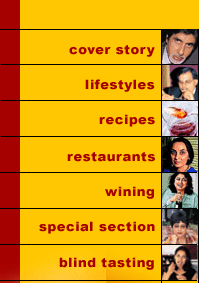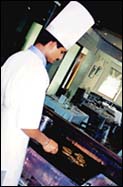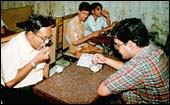

|
A stone from Hyderabad
The next time you are in Hyderabad, go to the Charminar area and shop for the black unpolished granite stone used for broiling lamb steaks for the famous pathar ka gosht. The stone should be flat, not more than two inches thick, and seasoned with years of cooking, preferably by the nizam�s khansamas. Chances are you won�t find it, but it�s worth a try.
The only such stone that exists in Bombay is at Nizam�s Heritage, the Hyderabad speciality restaurant at Byculla (at Hotel Heritage). It is a gift of Mir Hussain Ali Moosavi, a direct descendant of the great chefs of the Nizam�s personal banqueting service, to the restaurant.
The restaurant keeps the stone in its glass-enclosed display kitchen, and customers are welcome to see the pathar ka gosht being prepared on it. The stone is heated over glowing charcoals, the meat flattened and thinned, marinated for eight to ten hours in raw papayas, green peppers and garam masalas, is placed on the pathar and grilled. And served direct to the customer. The pathar, incidentally, is never washed, like the French frying pans.
Mock Seaweed
For starters, or with your second whisky, try the crackling spinach. To my knowledge, at least three restaurants in Bombay serve it, all with uniform expertise. Mainland China at Saki Naka, Andheri, Oriental Odyssey at Meadows Street (now Nagindas Master Road) in the Fort, and Moti Mahal off Turner Road, Bandra.
It is actually mock seaweed. In Hong Kong they serve it as seaweed. Here, though we have become sufficiently daring in our food habits to eat raw fish (adequately marinated), we wouldn�t touch seaweed. So these worthy restaurants have substituted spinach, the good old palak bhaji. They have transferred it into a magical item of crispy, crunchy food. And, of course, you will not recognise it.
The spinach is very finely shredded, then deep fried to give it the crunch. A generous amount of sesame seeds are added to provide a nutty flavour, plus salt and pepper, a chopped chilli, and a little
sugar, in case the palak turns out to be bitter. You can feel it crackling in the mouth, taste the sesame,
the spinach, the
edge provided by
the chilli.
Sancha ice cream
There is still one place in town which serves genuine hand-made ice-cream, what was once known as the sancha ice cream. The milk, sugar and other ingredients that go to make the ice-cream are put in a mole. The mole is sealed and put in a larger container packed tight with ice.
A handle is passed through and it churns the mole. The entire family takes part in turning the handle and churning the ice-cream. More ice is added, more churning. Two hours later, the ice-cream is ready. That�s how we used to eat the ice-cream before Kwality and the rest came along.
However, there is still one shop in town which makes sancha ice cream, though the handle is now motorised. Otherwise the process is as old as the first day gentlemen of 70 tasted their first ice-cream. The shop is Taj Ice Cream at Khara Tank Road in crowded Bhendi Bazar. If you are dead keen on eating the sancha ice cream, you will find the place. The proprietor is Abbasbhai Icecreamwalla, he is the fourth generation in the same business, same shop, same formula.
He adds no essences to his milk, no powder, no outside agents, only fruits. The milk is boiled on a slow fire for six hours, till it becomes a rabri, and it is this rabri that is put into the sancha. The resultant ice-cream is thick, heavy with milk and cream, and even when it is stirred and melted, it remains thick. Try the custard-apple, the fruit is creamy, the milk is creamy, the ice-cream is old-fashioned. So, who�s afraid of Haagen Daaz!
The Old, Old Shamiana
I am still mourning the end of the Taj�s old Shamiana. I remember August 27, 1972, when it opened with the young Subir Bhowmik as its manager. Two years later, Hemant Oberoi arrived as a young trainee chef and went straight into the Shamiana kitchen. The coffee shop has been a training ground and career starter for many of the Taj chain�s best.
Shamiana had all the firsts: the first coffee shop in the country to be open 24 hours; the first in the world to have an all inclusive menu, from a la carte to set meals, and New Zealand lamb chops to pink salmon New Orleans style, marinated with Creole spices; among the first to have exclusive children�s food; the first to be advertised in movie houses; probably the only coffee shop in the world to have more locals than travellers, more outsiders than hotel passengers; and the only place where I could eat a Currimbhoy salad.
So, what about the new Shamiana? I don�t know, I have not visited it � probably never will.
Coffee in buffalo milk
For the best coffee in town (strong, dark and frothy), I vote the Mysore Cafe in the King�s Circle crescent, which advertises itself as Bombay�s oldest cafe for South Indian delicacies. The coffee is made from what is known as the plantation seed, harvested in the hills of Coorg, and one which can compete with the best from Brazil.
According to Proprietor Nagesh Nayak, it is the way the seed is roasted, neither over nor under, and the way it is powdered (like crushing a rose petal), that is important. It is prepared in the South Indian filter, half a teaspoon of caramelised sugar spread over the filter, the coffee powder on top, and boiling water poured through a jet. And it is made with warm buffalo milk. Cow is healthy, but buffalo brings out the real taste in the coffee.
|

Home Page
About the mag
Subscribe
Advertise
Contact Us



